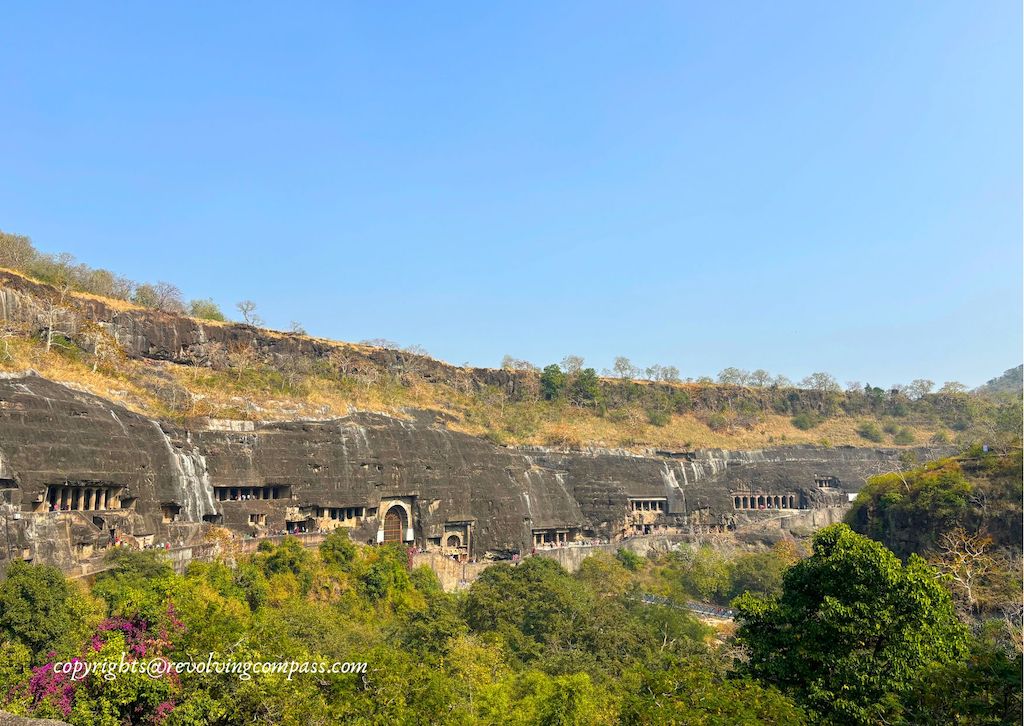Ajanta Caves in Aurangabad along with Ellora Caves are well known as the epitome of Buddhist art and architecture in India. And also the finest example of cave temple architecture in India. They are a UNESCO World Heritage site. And one of a kind cave temples in the world. To be honest, after visiting the Ajanta Caves and Ellora Caves during my Bangalore to Maharashtra road trip, I felt so overwhelmed. Both by the sheer expanse and the number of caves. As well as by the details that each cave present. That it took me a lot of time to think through how to best present them to my readers.
An introduction of Ajanta Caves Aurangabad
The Ajanta Caves are a series of almost 36 caves discovered so far. Built by cutting monolithic rocks that together form a horse shoe shaped structure. These hills lie in the gorge of river Waghur in Deccan Plateau. There are several seasonal waterfalls that fall over these caves in the monsoons season. Making them all the more picture perfect.
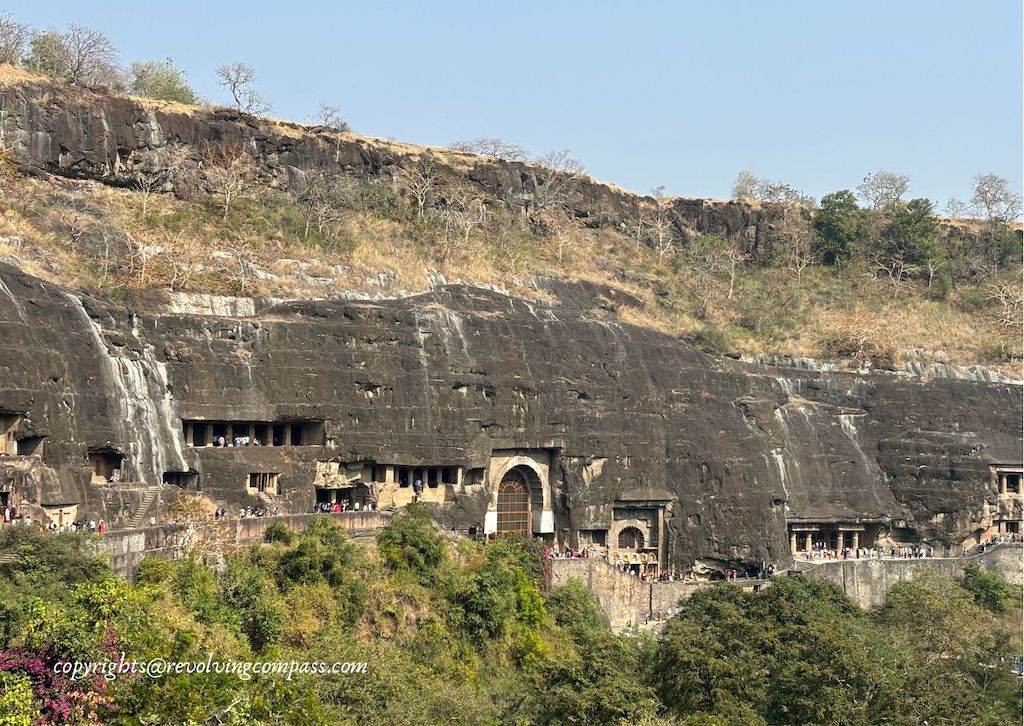
Most of the caves in Ajanta Caves are dedicated to Buddha. As such, these caves depict the life and times of Buddha and his disciples in the form of intricate and expressive paintings and sculptures or reliefs. They also have different forms of Buddha depicted in different caves. Which include Buddha sitting in meditation, preaching his disciples, sleeping Buddha and many others. The size and detailing of some of these temples is what takes your breath away. No wonder, the Ajanta Caves are considered one of the finest examples of ancient Indian architecture, are declared a UNESCO World Heritage Site and also considered masterpiece of Buddhist art in India.
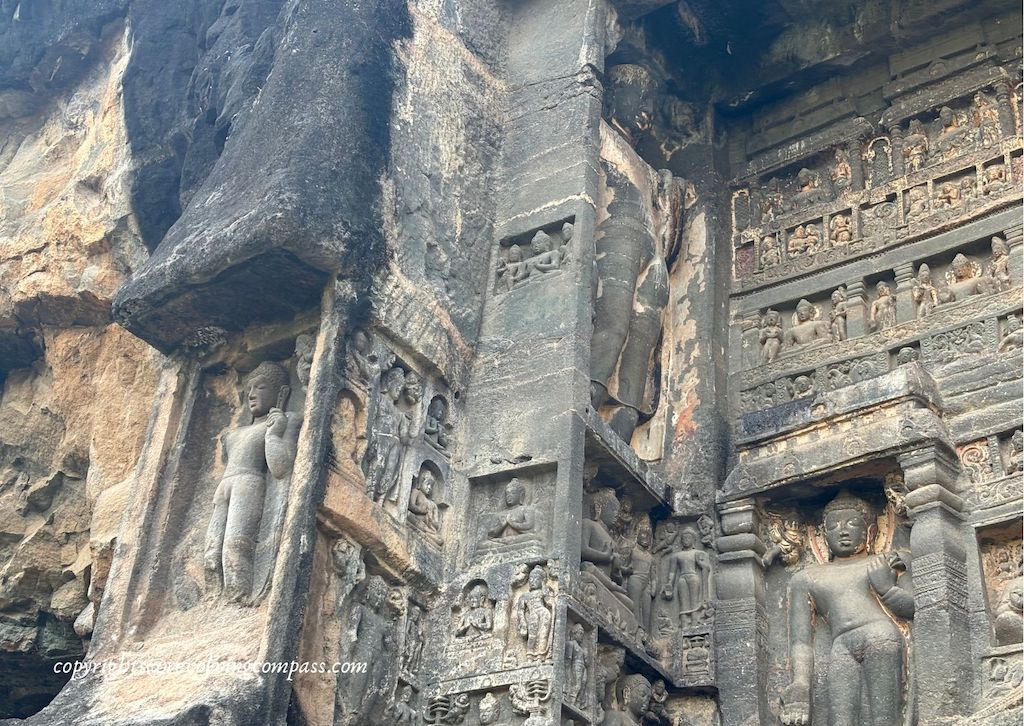
Although I have been to Thailand. And visited many Buddhist Temples there. Including a lot of temples on a walking tour of old city of Chiang Mai, Doi Stupa and many others. And even the Buddhist Temples on my trip to Bhutan. And seen some of the magnificent free standing temple complexes of India like Khajuraho Temple complex and another UNESCO World Heritage Site – the temple Complex of Pattadakal. But, I have never come across anything close to the way Ajanta Caves are built. They are just – something else!!
Discovery of Ajanta Caves Aurangabad
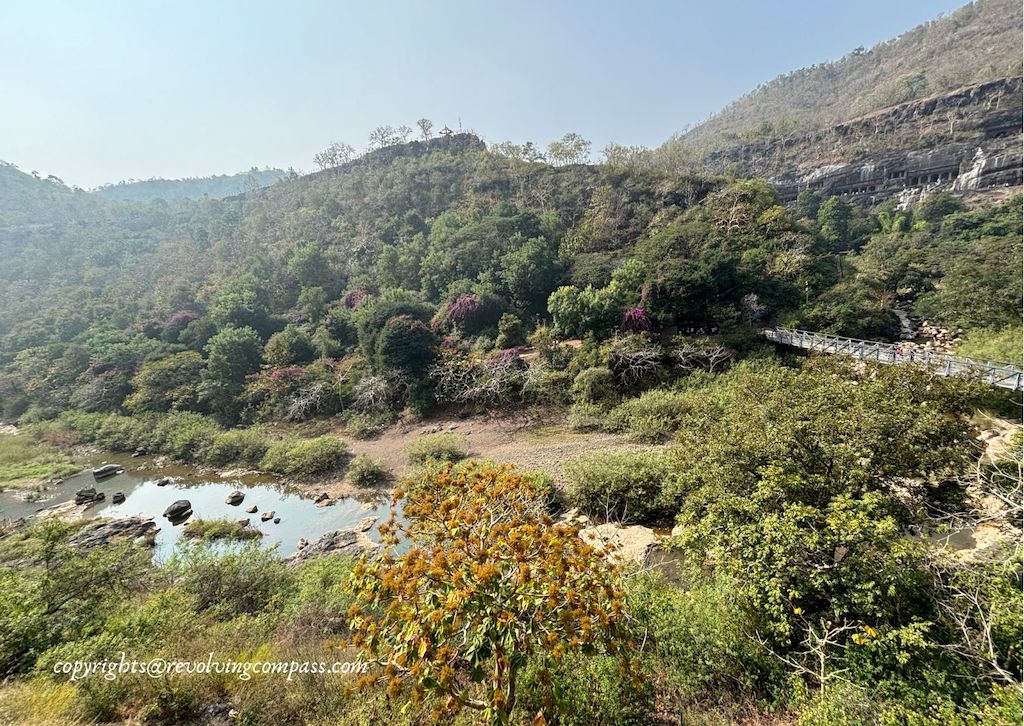
While the Ajanta Caves were built around 2nd Century BCE to 4th century CE. Later, they slowly got covered under thick forest vegetation. Hidden from site of everyone. And remained like that for centuries. It was only by sheer coincidence, that during his hunting trip, a British Officer came across them. And out of mere intrigue, he decided to get them cleared out of the jungle!!
There are many cave temples across India. Some 1200+. Out of those, around 900 are in Maharashtra. Some of these are also the oldest. So, Maharashtra can easily be called the cradle of cave temples in India. Just like how Aihole is called the school of temple architecture in India. Some of the other cave temples in Maharashtra include the Pandavleni near Nashik, Bhaja and Karla Caves near Lonavala and Elephanta Caves near Mumbai.

Some other prominent cave temples that I have visited in India include the Udayagiri Cave Temples in Madhya Pradesh near Sanchi and Vidisha. And the Badami Cave Temples on my trip to Badami, Pattadakal and Aihole. There are many more, some prominently in Orissa. And I hope to visit them soon.
Caves of the Ajanta Cave Aurangabad
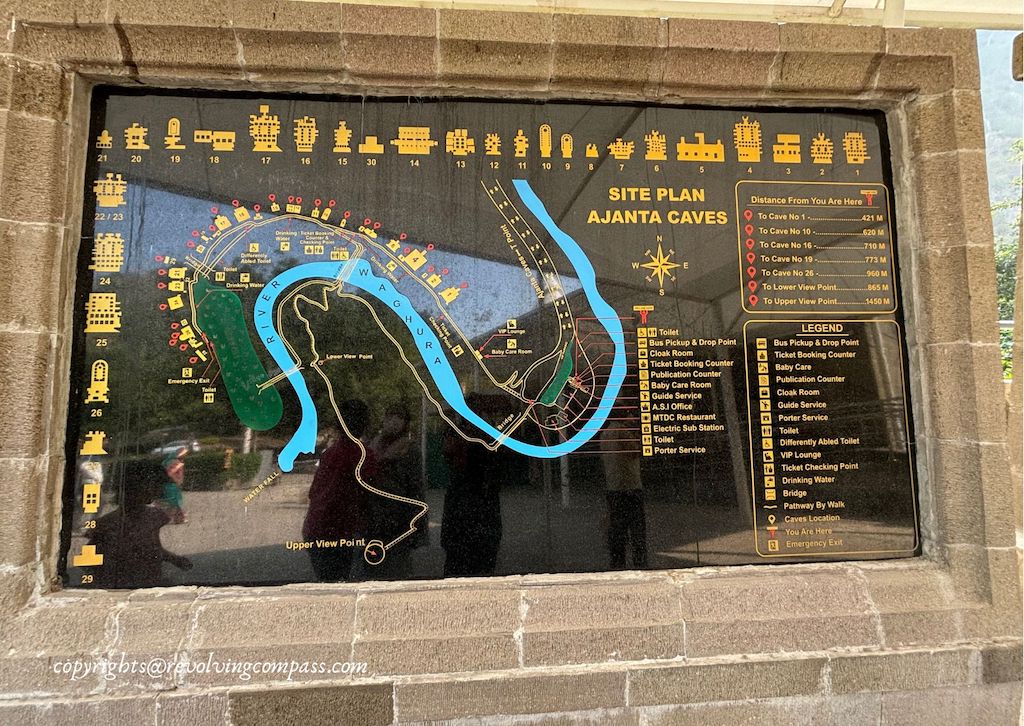
There are a total of 36 caves at Ajanta Caves. Out of these 29 are numbered as 1-29. And the rest are suffixed with alphabet. For instance, 15 A. Just like the Ellora Caves, some of the caves at Ajanta Caves are very big and prominent while some others are very small. Some caves have two floors or even three floors. They are one of the oldest examples of multi-floor buildings from ancient India. Let me quickly take you through the caves at Ajanta Caves.
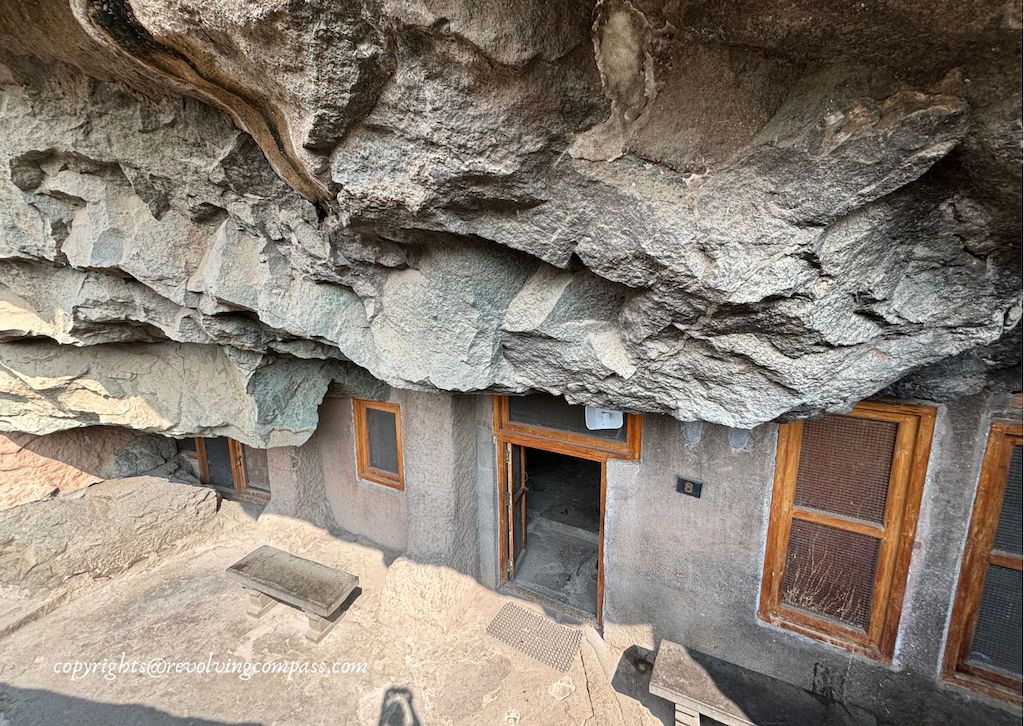
Prominent features of the Ajanta Caves
The main features of the caves at Ajanta Caves include –
- Monasteries, also called “Viharas” as seen in cave 9, 10 and 19. Most of these have an outer Verandah, a large hall inside supported by ornate pillars. With a large central stupa in the middle of the cave.
- Prayer Halls or meditation halls for the Buddhist disciples also called “Chaityas”
- Living quarters of the Buddhists
Paintings of the Ajanta Caves
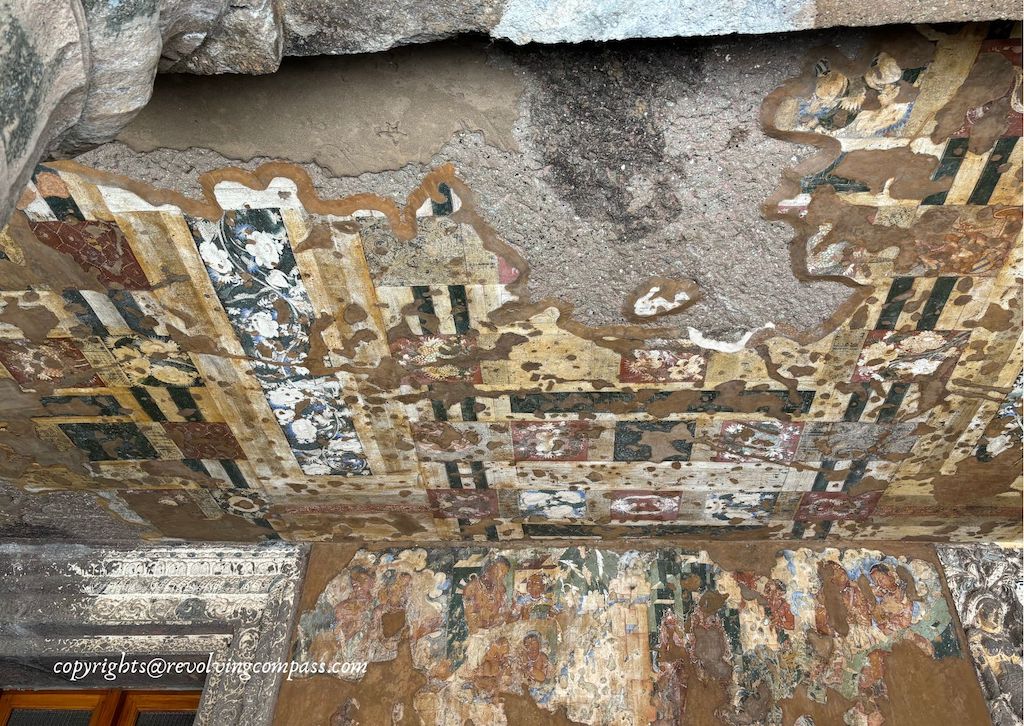
Amongst the paintings and sculptures at Ajanta Caves, you can see –
- The depiction of different forms of Buddha including ipasyi, Sikhi, Visvbhu, Krakuchchanda, Kanakamuni, Kashyapa and Sakyamuni.
- Story of rebirth of Buddha
- Jhatka Tales depiction. Stories like “Miracle of Sravasti” and “Temptation of Mara” can be seen on the two storey cave 6. And the story of Udayin and Gupta, the story of Nalagiri, the Wheel of life in cave 17. Some of the reliefs of cave 17 also show the various musicians and artists of the time. Some of the important and famous tales seen across the caves include Shaddanta, Hasti, Hamsa, Vessantara, Sutasoma, Mahakapi, Sarabhamiga, Machchha, Matiposaka, Shyama, Mahisha, Valahassa, Sibi, Ruru and Nigrodamiga Jatakas. And many of these are seen in cave 17.
- Buddhist deities
An armchair tour through the caves of Ajanta
Cave 1 – Cave 17
Amongst the caves, caves 1,2, 16 and 17 are the largest ones with prominent paintings, most of which are still intact. They are the oldest surviving Indian Wall Paintings. Cave 2 interestingly has a very feminine focused painting. As you see a lot of female depictions here.
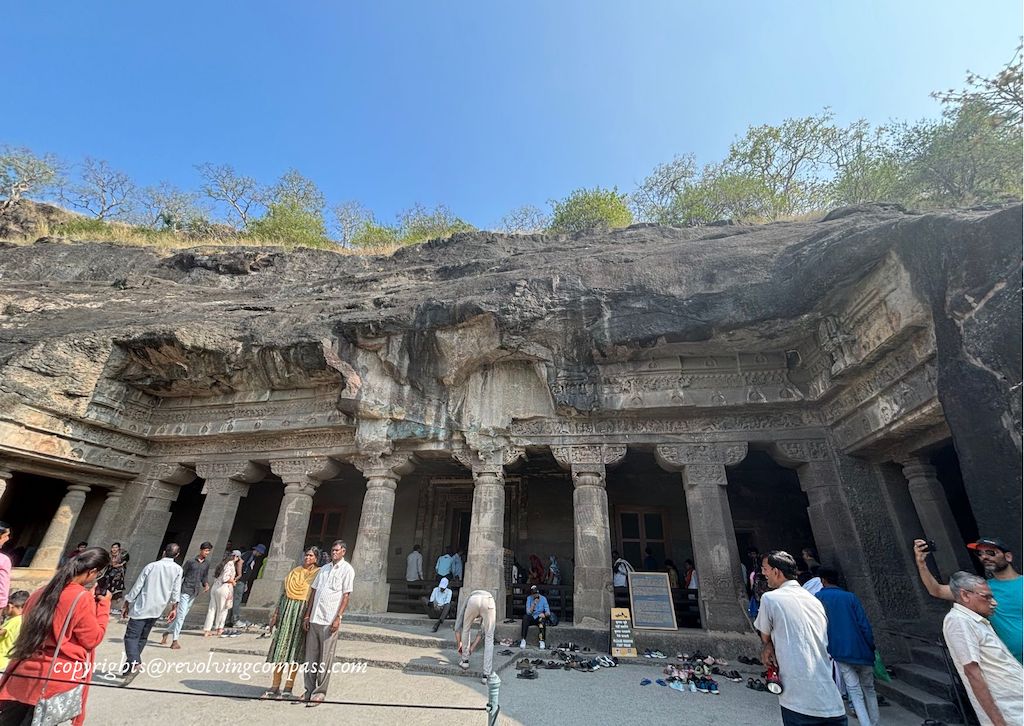
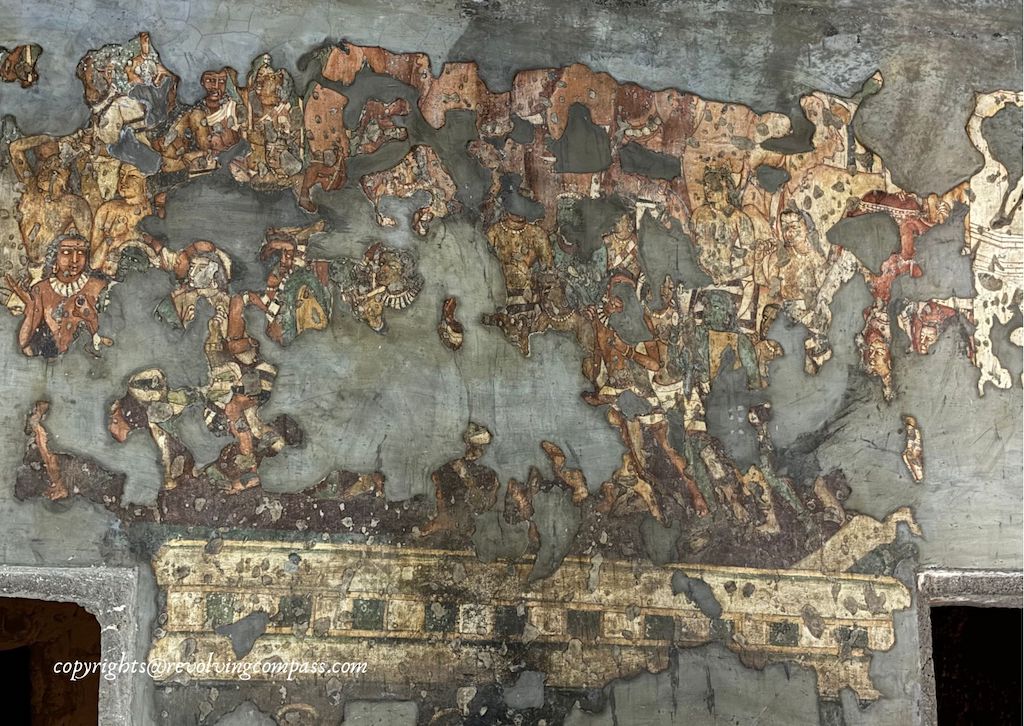
While the earliest caves are caves 9, 10, 12, 13 and 15A.
Cave 4 is a large Vihara with Buddha in the centre in a preaching pose. While Cave 3, Cave 5 and Cave 8 are unfinished excavations. Mostly devoid of architectural details.
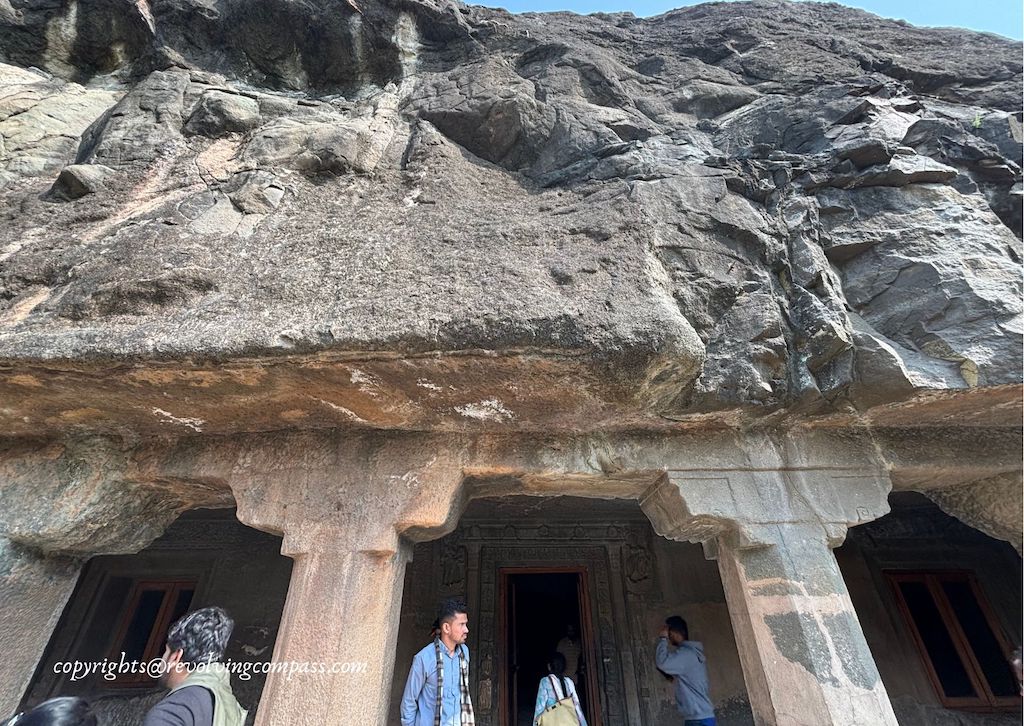
Cave 6 is two-storey monastery. While it’s lower floor is a monastery, the upper floor seems incomplete.
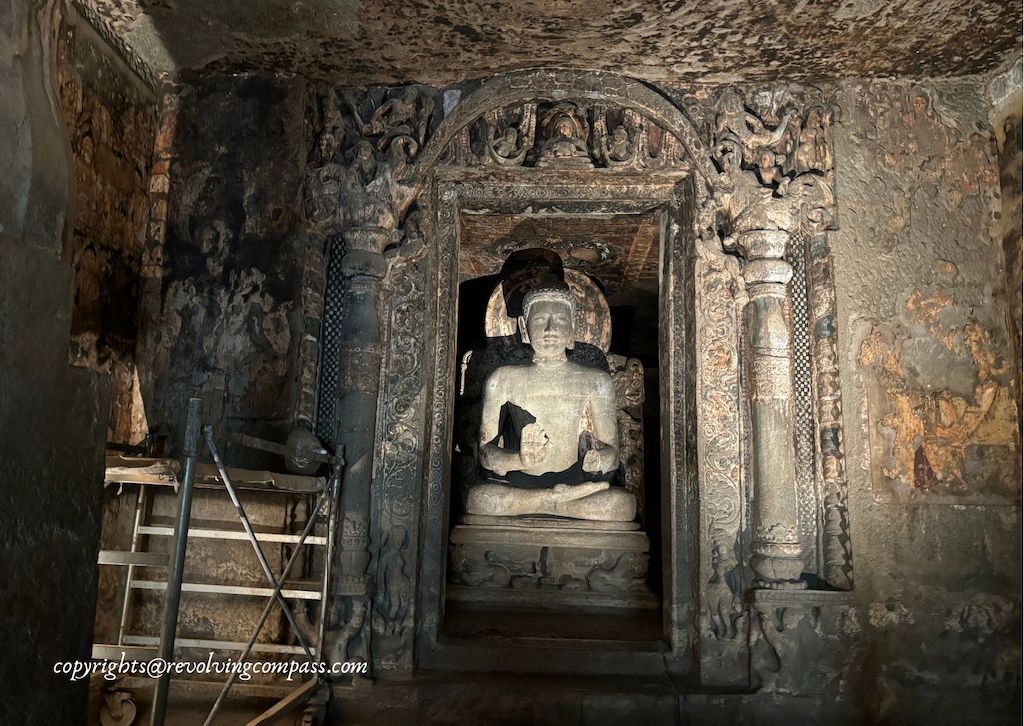
Again, cave 7 is a large cave with ornate pillars supporting the Verandah and massive interior hall with Buddha’s paintings and reliefs.
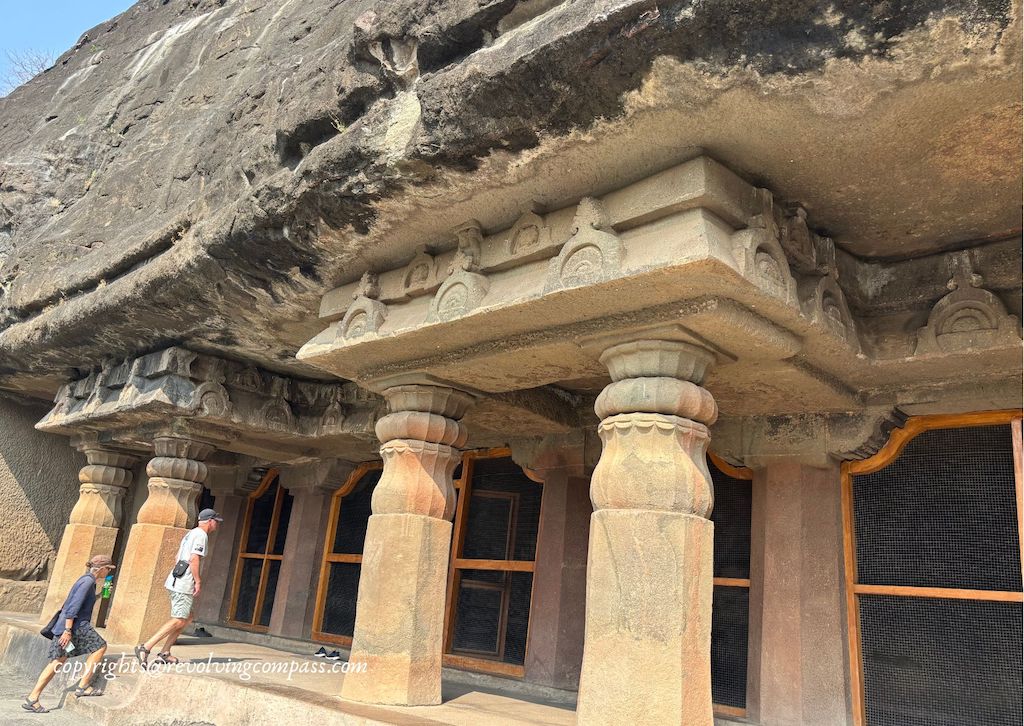
Cave 9 and 10 are chaitya or, worship halls. The entryway to cave 9 is a whooping double storey architectural magnificence. Something that will remind you of the Petra Entryways in Jordan.
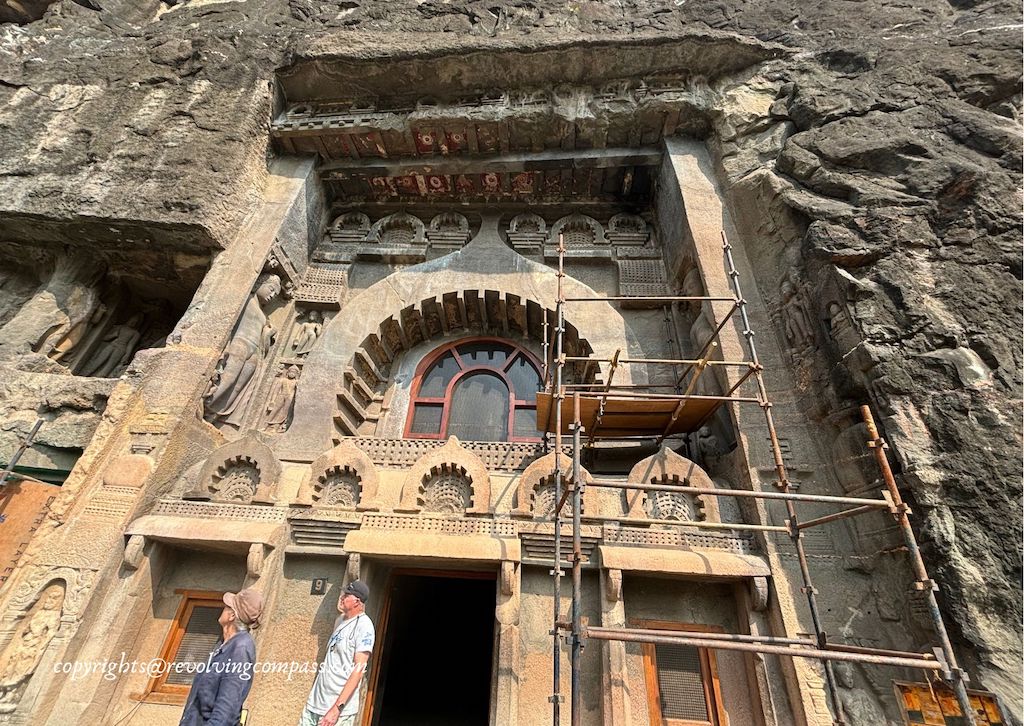
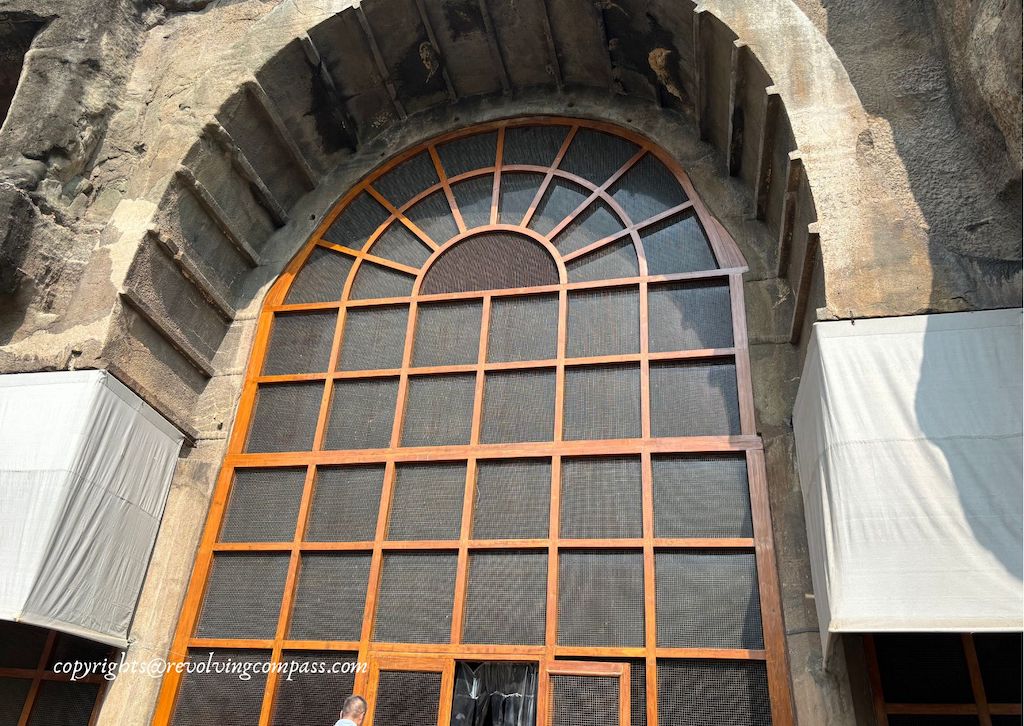
After this there are several cave monasteries including Cave no 11,12, 13 and 15. While cave 14 is an incomplete monastery.
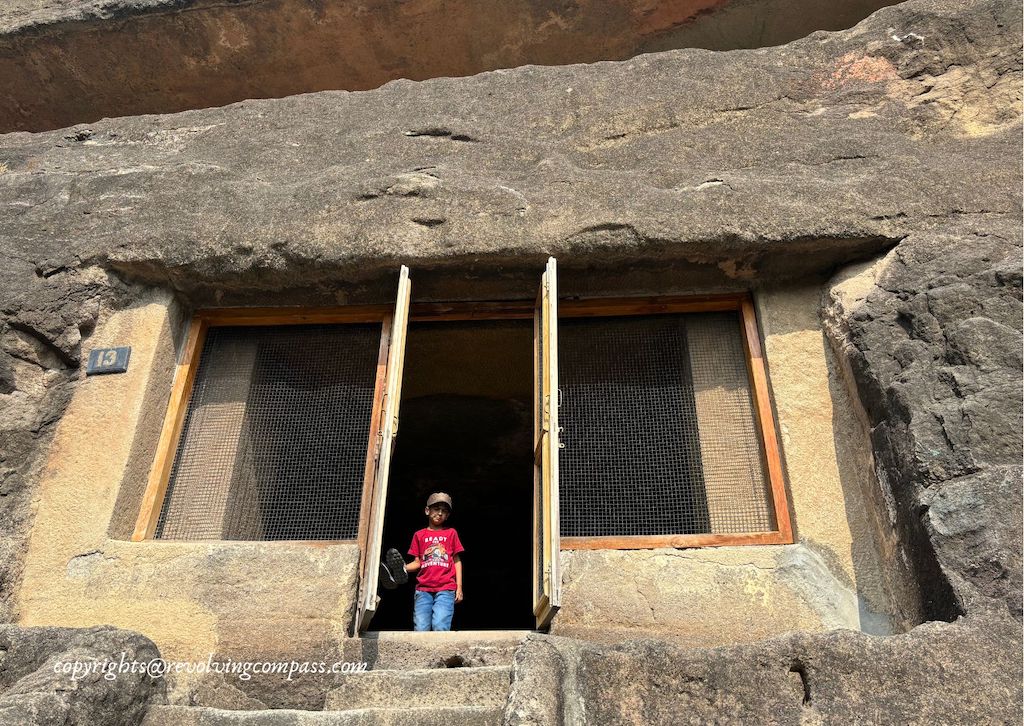
While Cave 16 is one of the largest and also having massive paintings depicting the Jatka Tales. It also lies at the centre of the site of Ajanta Caves. This one and the adjacent cave 17 have monolithic elephants at their entryway – something that distinguishes them from rest of the caves. Cave 17 also has one of the longest inscriptions of all caves. Believed to be from the Upnishads.
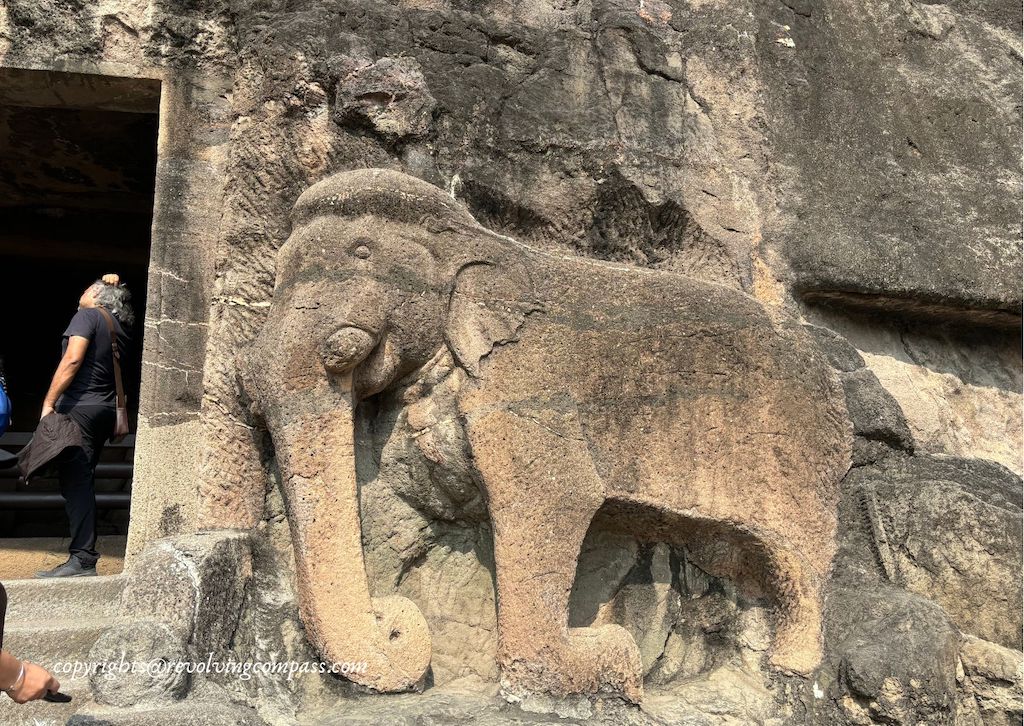
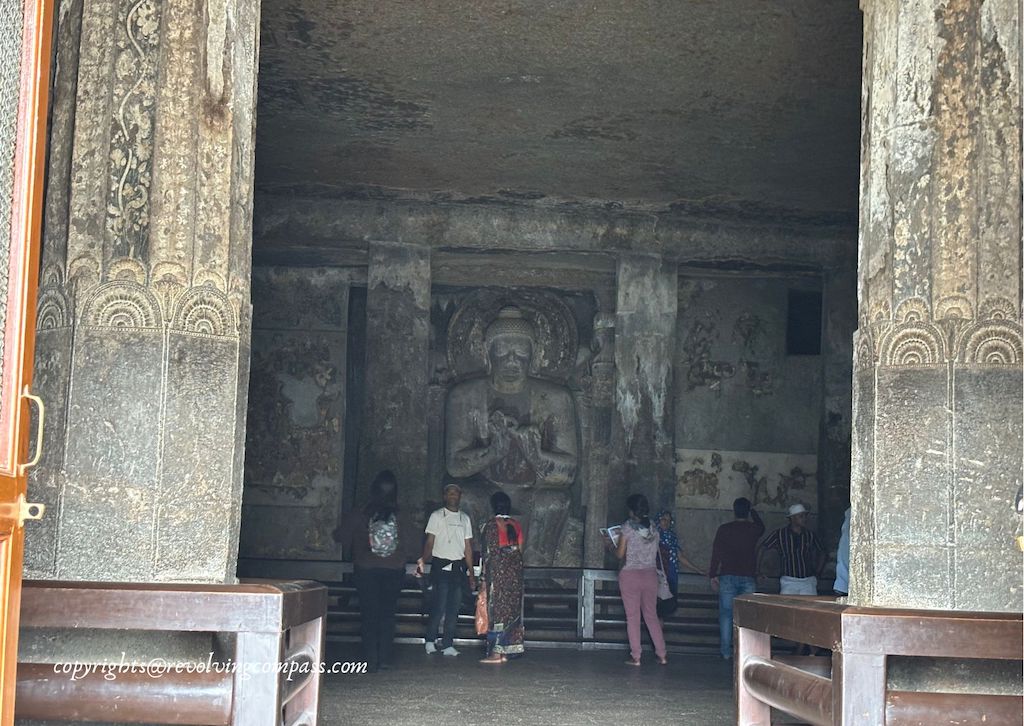
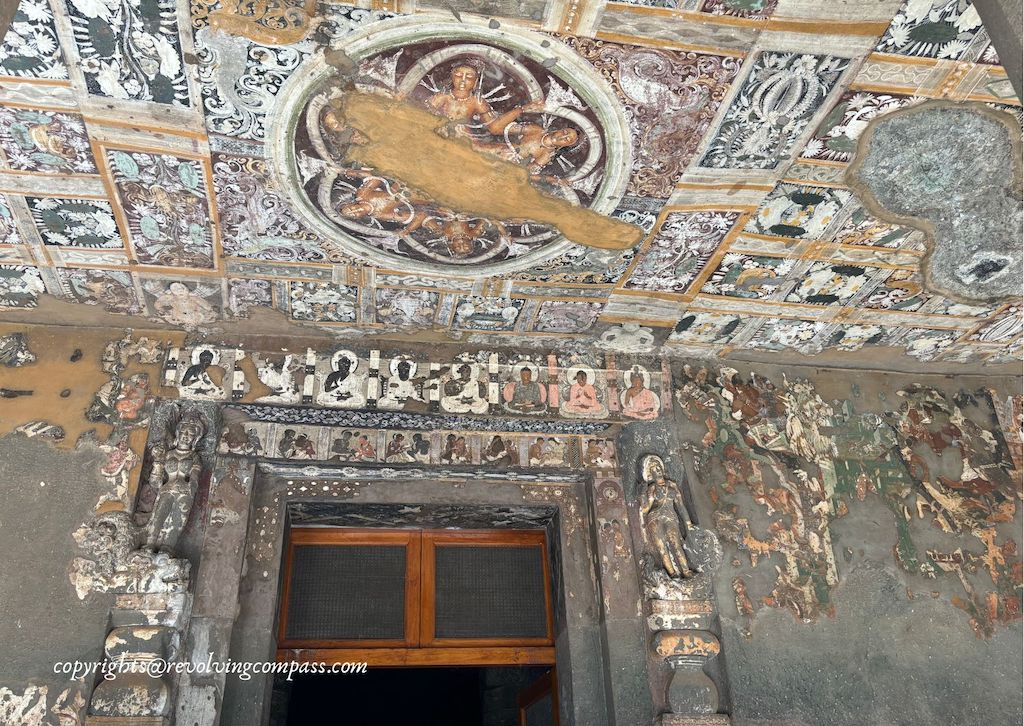
Cave 18 – Cave 29
Cave 18 is once again a small and insignificant one. But, cave 19 besides it is again a huge worship hall. Which once again shows Buddha in different poses. And a naga figure protecting the Buddha statue. Cave 20 is smaller but has exquisite details.
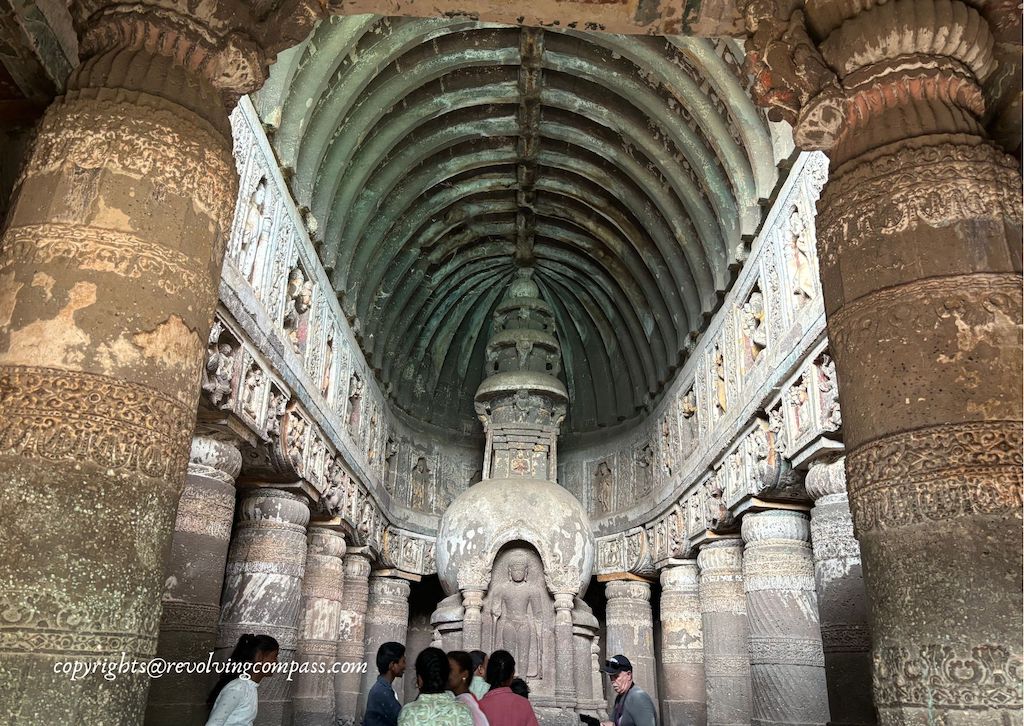
Again, cave 21 is very ornate. It contains 12 inner rooms or chambers where the Buddhist monks resided. And also has a lot of ornate pillars with detailed carvings and reliefs of apsaras, Nagaraja and Nagarani, flowers and animals among others.
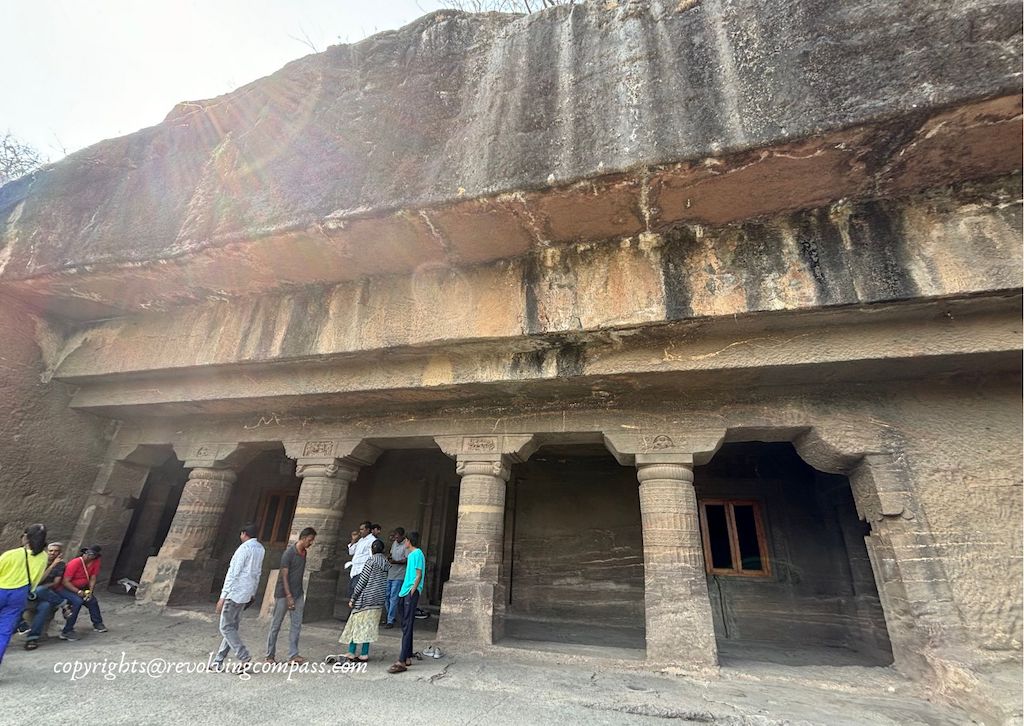
Caves 22,23 and 24 are unfinished. But, Cave 24 is larger than the rest.
Further Cave 25 is a monastery while Cave 26 is a worship hall. The entrance to Cave 26 resembles that of Cave 19. Once again, it is one of the most ornate caves. With sculptures finely detailed. Carved pillars and beautiful reliefs.
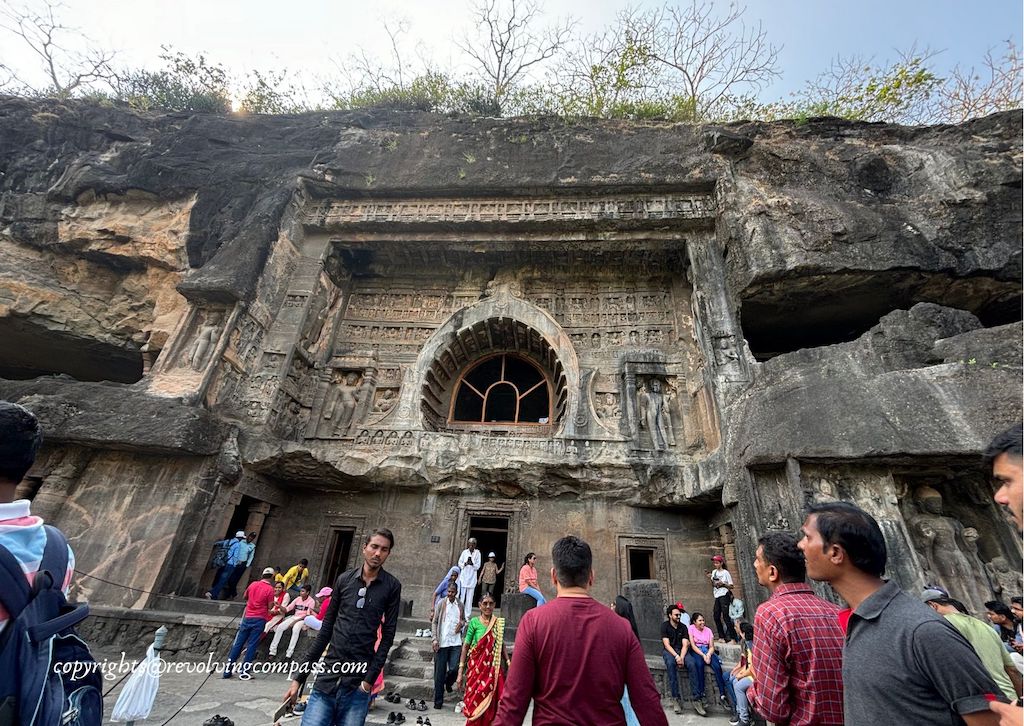
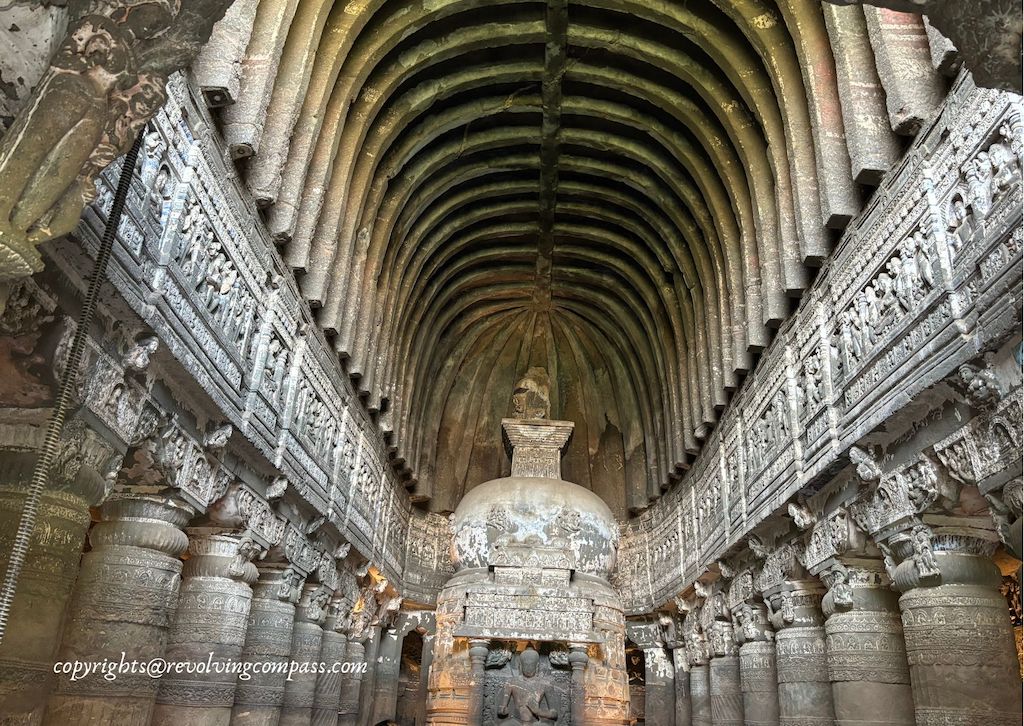
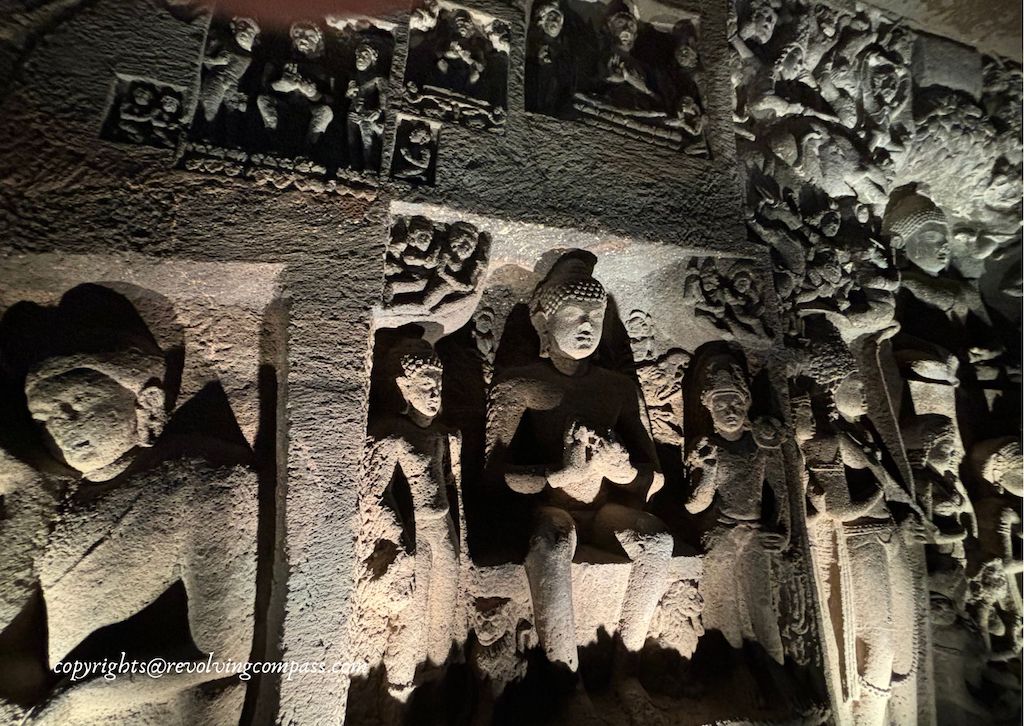
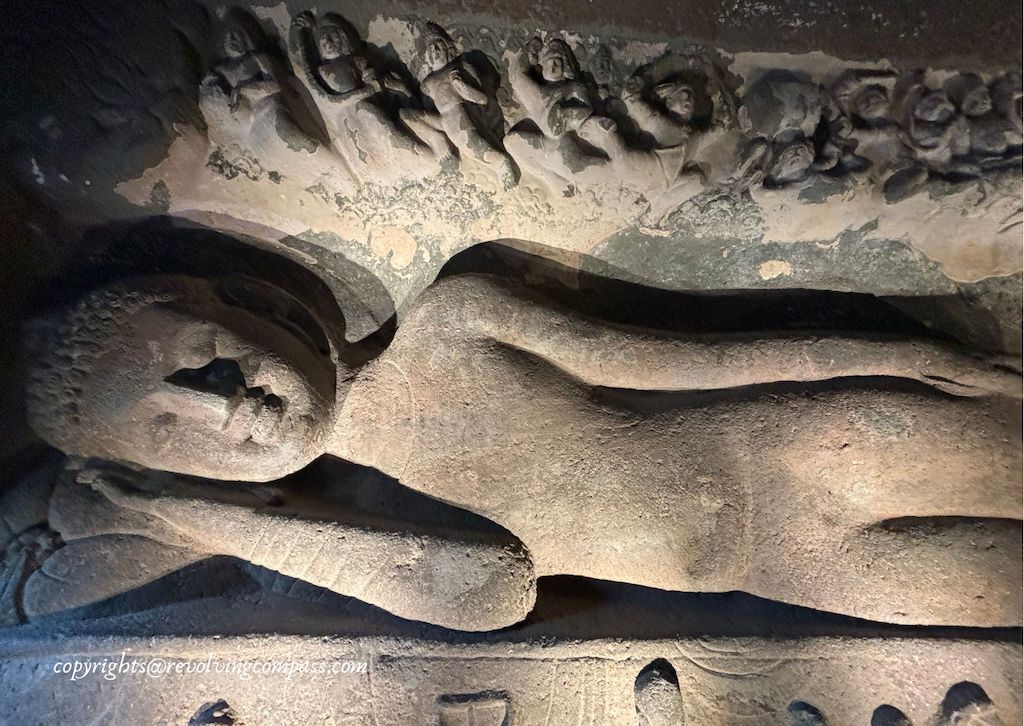
Caves 27 to 29 are again unfinished monasteries.
So, in summary, if you need to choose a few caves to visit. I would say the must visit caves at Ajanta Caves are the Caves 1,2, 4,6,7,9,10,16,17, 19,20 and 26.
General Information on visiting Ajanta Caves
When is the best time to visit Ajanta Caves
Monsoons are considered as the best time to visit Ajanta Caves. Because the whole forest region gets very green in the monsoons. And numerous waterfalls emerge. Which fall right from the top of these caves. However, one must be careful visiting the Ajanta Caves during monsoons. As, there can be chances of landslides also in the region. Winter months are also good to visit here. The daytime temperature usually remains as high as a min of 26-27 degrees. While mornings and evenings are pleasant.
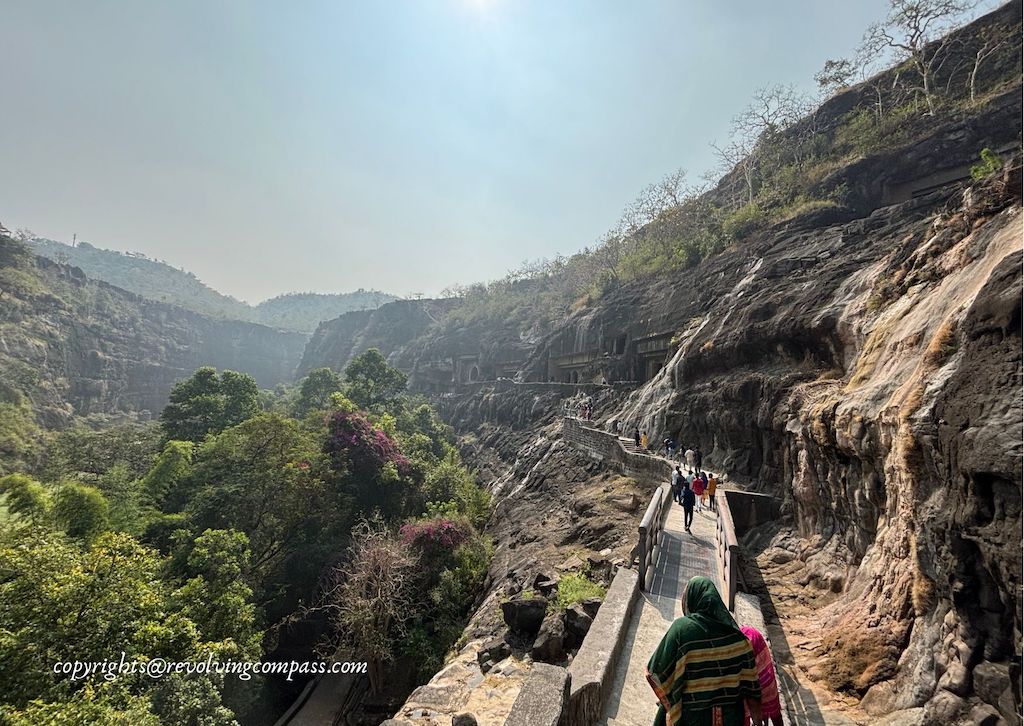
What is the timing of Ajanta Caves
Ajanta Caves are open for public from 9:00am to 5:00pm. Do note that the Ajanta Caves are closed on Monday.
How to reach Aurangabad
Aurangabad has excellent connectivity to nearby cities and towns by road. We drove from Nashik to Aurangabad on the Samruddhi Mahamarg and NH 160.. The Samruddhi Marg is part of the newly built Nagpur – Mumbai Expressway, also called Hindu Hrudaysamrat Balasaheb Thackeray Maharashtra Samruddhi Mahamarg. This expressway connects Mumbai to Nagpur via Nashik, Shirdi and Aurangabad.
Aurangabad also has excellent connectivity to Hospete and Hubli in Karnataka via NH 52 and NH 50 respectively. On the way back to Bangalore, we drove from Aurangabad to Hospete via NH 52 which was in excellent condition through and through.
Also, Aurangabad is well connected with Hyderabad and other towns of Andhra Pradesh. In fact, in ancient times, it was a part of the princely state of Hyderabad.
Aurangabad also has a railway station. And an airport. Through which it is connected to all the major towns and cities of India.
How to reach Ajanta Caves
Ajanta Caves lie at almost a 2 hrs distance from the main city of Aurangabad. Which is ~100km. More or less the road to Ajanta Caves is in good condition. But one needs to drive through populated towns on the way which slows one down. You can also hire a taxi for a trip to Ajanta Caves. Or, take this guided tour to Ajanta Caves.
Upon reaching the Ajanta Cave complex, you can park in their huge parking complex. Washrooms are also available on one side of the parking complex.
Parking vehicle and taking bus to Ajanta Caves
After parking the vehicle, you need to walk around 5 mins to a point from where you take a bus to the main cave complex. As it is located far from the main road.
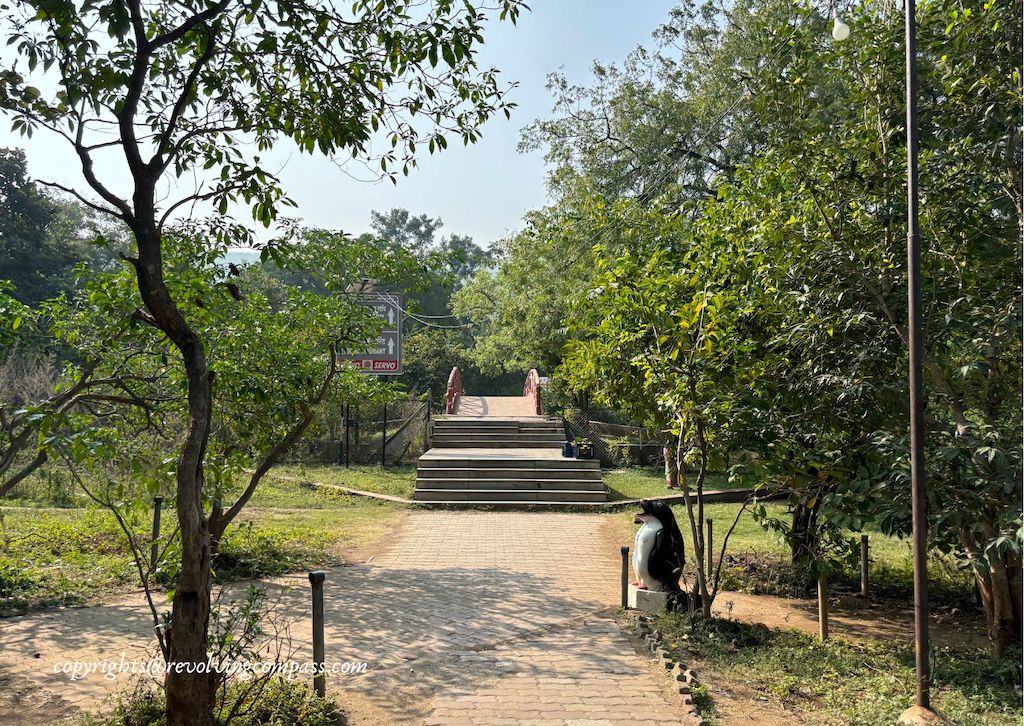
There is a queue at the bus stand. As the buses come every 5 mins or so, people keep getting into them in first come first serve basis. At the entry to the bus, you can take ticket for the ride. A one way ride in a non AC bus costs INR 25. And a one way ride in an AC bus costs INR 30.
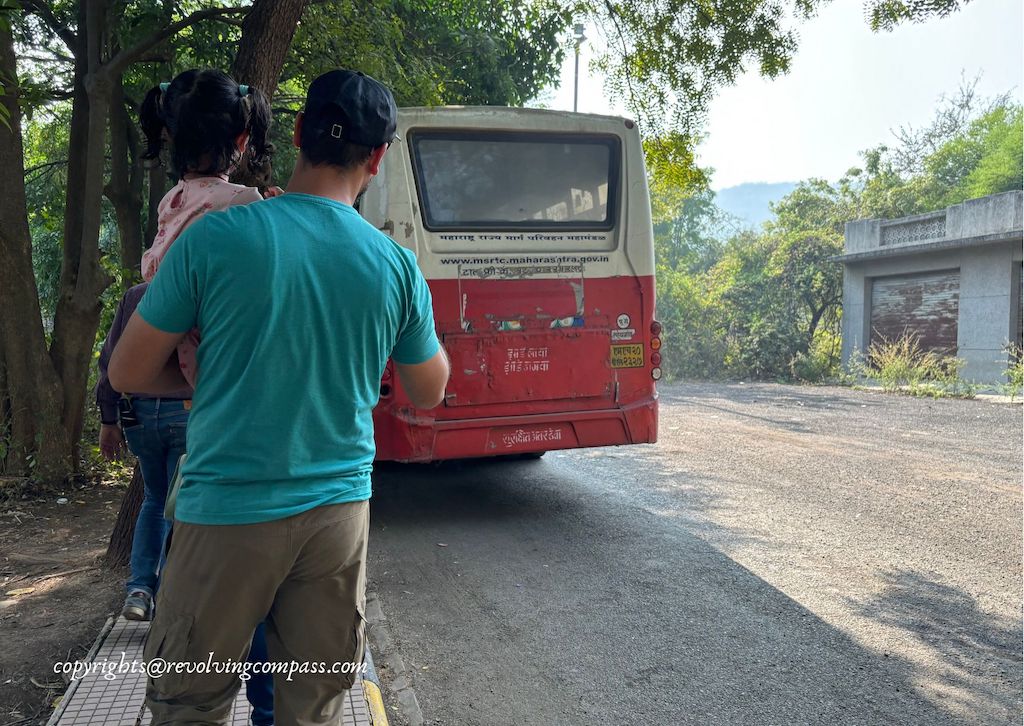
The bus ride is a 5-7 mins ride through a narrow road uphill. Half way uphill, the base complex of Ajanta Cave arrives. You get down the bus and then walk to the entry. You can take your tickets here, or, you can also book them online. Online tickets are Rs 5 cheaper than the ones you take at the counter. To encourage online tickets and reduce queues at the ticket counters.
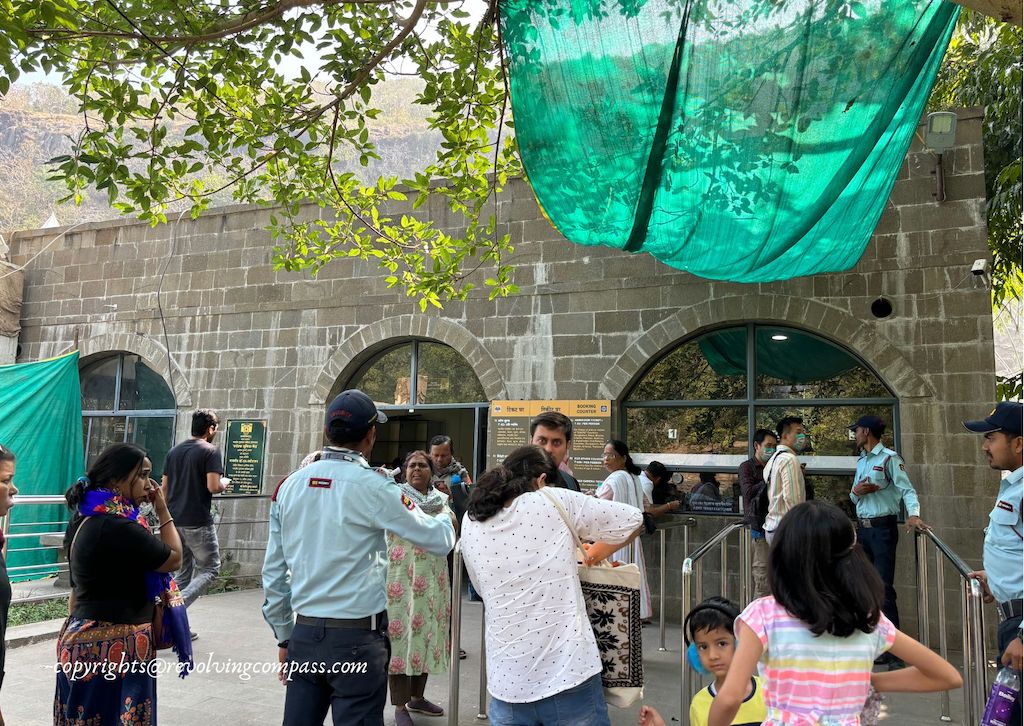
Stairs to the top of hill to Ajanta Caves
Along with the ticket counter, the complex also has a restaurant, clean washrooms and sitting area outside under trees. Overall the facilities are well maintained here.
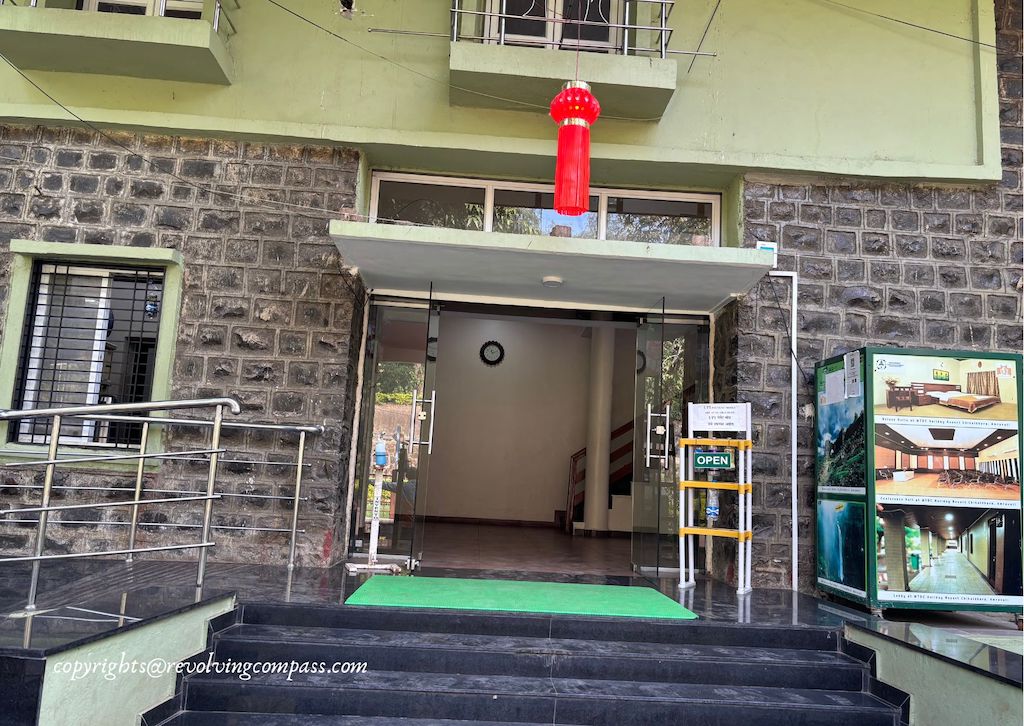

From here, one needs to take some 150 steps to reach to the top of the plateau where the Ajanta Caves are located. Unlike the other caves that visited in Maharashtra, the climb to Ajanta Cave has two options. You can either take the stairs or you can take the slightly sliding curved pathways which are more gentle on the legs. Nevertheless, the stairs get over soon.
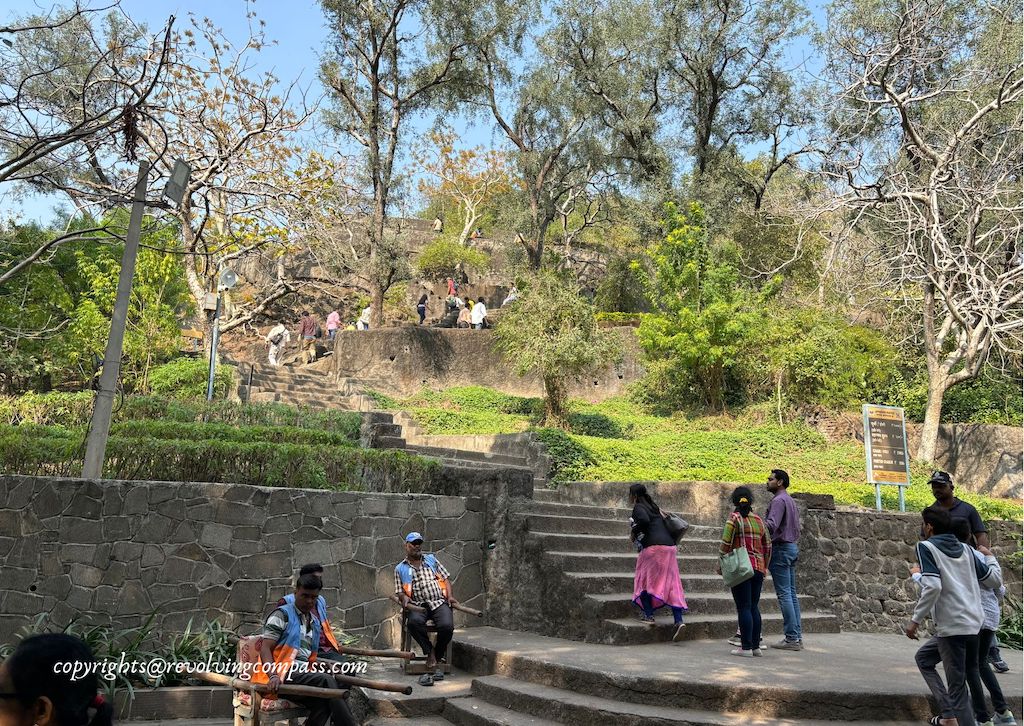
Overall because of the drive from Aurangabad, bus ride and then climbing the stairs, it can take anywhere between 2.5 – 3 hrs to reach Ajanta Caves from your accommodation in Aurangabad City.
Many a times, people also combine the visit to Ajanta and Ellora Caves. As they are ~60km apart (1 hrs apart). People often take a guided trip to both Ajanta and Ellora Caves. But, I personally feel it will be too overwhelming to visit both of them together. As each one of these needs at least 4-5 hrs to explore completely.
What is the entry fee to Ajanta Caves
The online entry fee to Ajanta Caves is INR 35 per adult. Kids below 12 years of age have free entry.
Apart from the entry fee, there is a bus ride to take from the parking lot to Ajanta Caves. The Non-AC bus ticket costs INR 25 while AC bus ticket costs INR 30.
Where to stay in Aurangabad
This is the complete list of hotels in Aurangabad city. There are many budget as well as luxury hotels in Aurangabad. Including the likes of Lemon Tree Aurangabad, 7 Apple Aurangabad and many more. We stayed at Hotel Grand Kailash in Aurangabad, which is a newly built property. Although small scale, their cleanliness and service was exception. They even packed us a breakfast when we were leaving very early in the morning from Aurangabad city the next day. They have limited parking inside campus and in the basement. And some more parking space right outside the campus. Overall we had a very comfortable stay here.
Are Ajanta Caves temples or caves
Ajanta Caves are both temples and caves. Inside the caves, there are buddhist temple viharas, monasteries, idols of Buddha and his several forms present. As a result, one is expected to show the respect one shows when visiting Hindu Temples and Buddhist temples. Like, removing your shoes before entering into each of the caves at the Ajanta Caves.
How much time is needed to explore Ajanta Caves
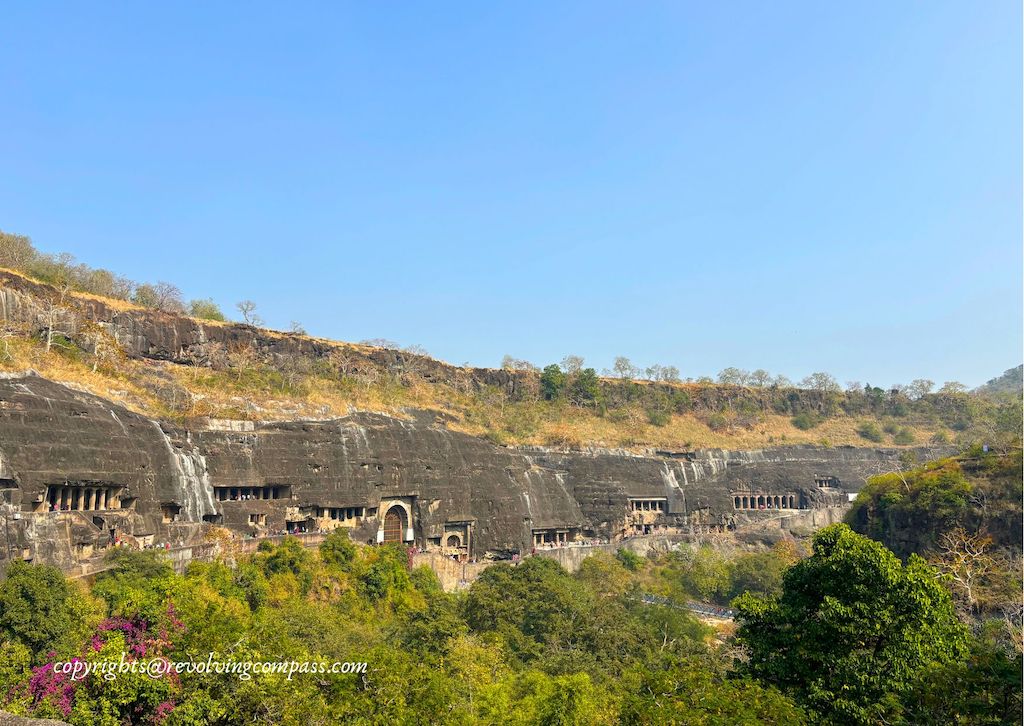
You should reserve at least 3-4 hours to visit Ajanta Caves apart from the travel time to and from the caves. We started from our hotel in Aurangabad around 8:30 am in the morning and reached Ajanta Caves around 10:30 am. From the parking to the caves, it took us another 30 – 45 mins. By 2:30 pm, we started back from the caves. When we came down, we had our lunch in the market that is setup around the path to the bus stop. Then around 4:00pm, we started back for our hotel and reached back by 6:00pm. So, overall, we dedicated one full day to our trip to Ajanta Caves Aurangabad.
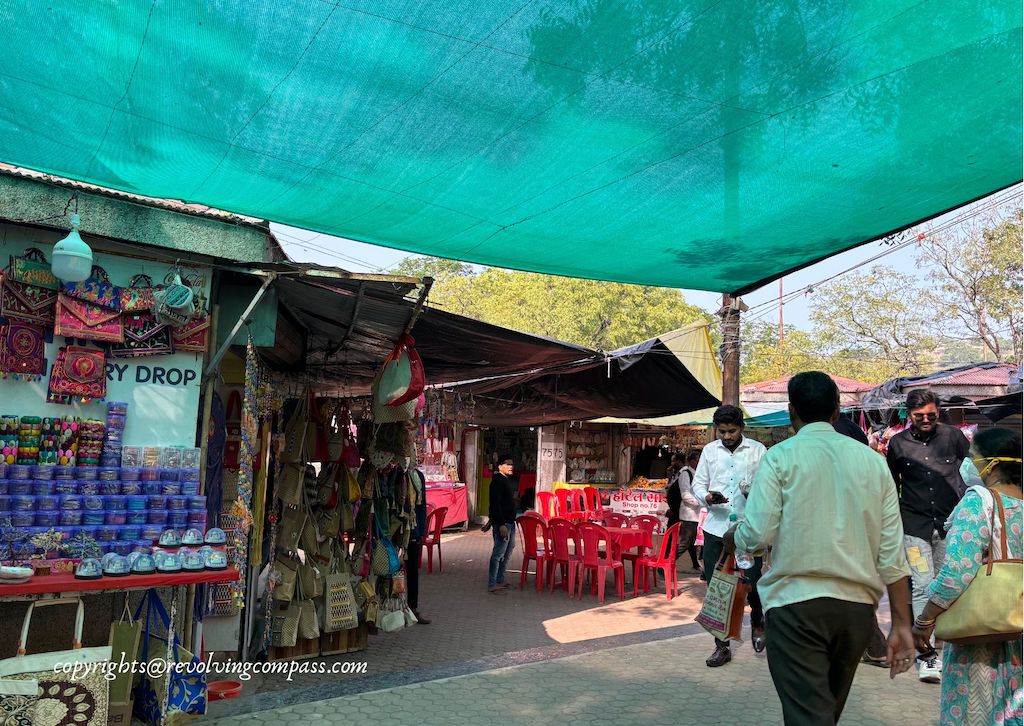
General tips on visiting Ajanta Caves Aurangabad
- Wear comfortable cotton cloths
- Don’t forget your sunglasses, a hat or umbrella, and sunscreen lotion
- Wear slip on shoes that have good grip. Like these walking shoes. So that you can trek easily to the Ajanta Caves. And also easily get in and out of your shoes when entering into the cave temples.
- Carry drinking water with you. There are facilities at the cave to refill your bottles. And packaged drinking water is also available
- You can also pack your food with you. And have it while visiting the temple complex. That way, you will not need to hurry back when hungry 🙂
- When visiting Ajanta Caves with kids, definitely pack some food, snacks and water for them
- Also, my younger one felt a little dehydrated walking in the sun all day. And end of the day, I gave her an ORS solution. It will be good to carry a rehydration solution for kids instead of plain water, particularly if you are visiting on a sunny day.
